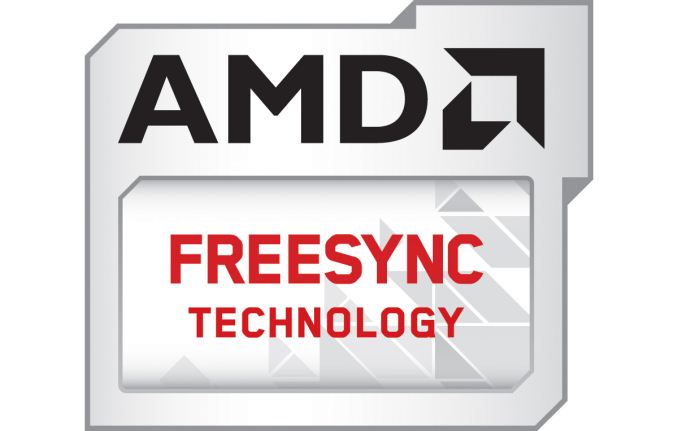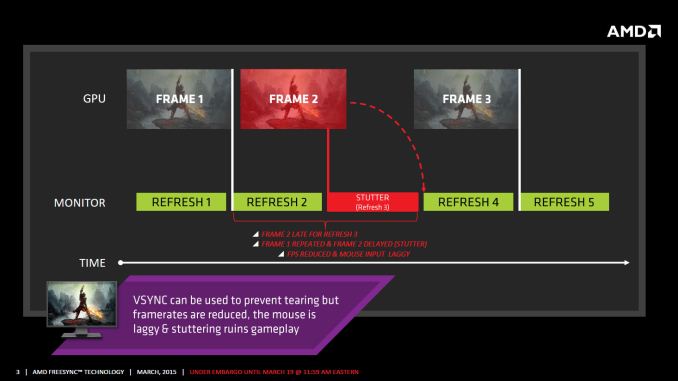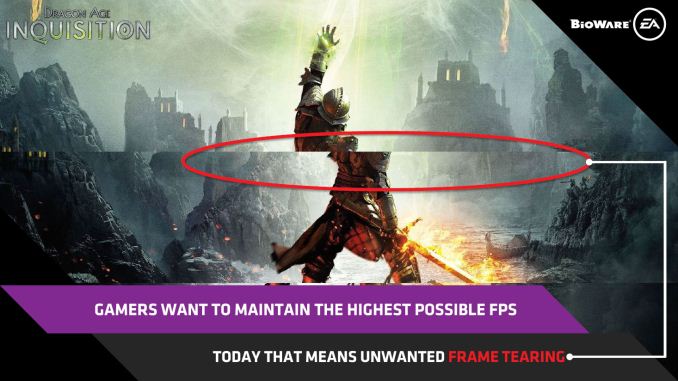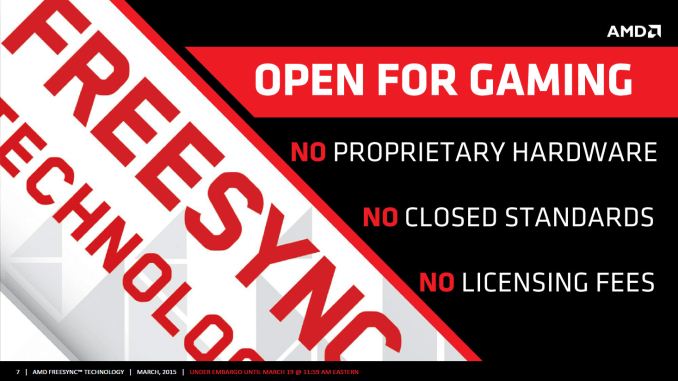The AMD FreeSync Review
by Jarred Walton on March 19, 2015 12:00 PM EST
Introduction to FreeSync and Adaptive Sync
The first time anyone talked about adaptive refresh rates for monitors – specifically applying the technique to gaming – was when NVIDIA demoed G-SYNC back in October 2013. The idea seemed so logical that I had to wonder why no one had tried to do it before. Certainly there are hurdles to overcome, e.g. what to do when the frame rate is too low, or too high; getting a panel that can handle adaptive refresh rates; supporting the feature in the graphics drivers. Still, it was an idea that made a lot of sense.
The impetus behind adaptive refresh is to overcome visual artifacts and stutter cause by the normal way of updating the screen. Briefly, the display is updated with new content from the graphics card at set intervals, typically 60 times per second. While that’s fine for normal applications, when it comes to games there are often cases where a new frame isn’t ready in time, causing a stall or stutter in rendering. Alternatively, the screen can be updated as soon as a new frame is ready, but that often results in tearing – where one part of the screen has the previous frame on top and the bottom part has the next frame (or frames in some cases).
Neither input lag/stutter nor image tearing are desirable, so NVIDIA set about creating a solution: G-SYNC. Perhaps the most difficult aspect for NVIDIA wasn’t creating the core technology but rather getting display partners to create and sell what would ultimately be a niche product – G-SYNC requires an NVIDIA GPU, so that rules out a large chunk of the market. Not surprisingly, the result was that G-SYNC took a bit of time to reach the market as a mature solution, with the first displays that supported the feature requiring modification by the end user.
Over the past year we’ve seen more G-SYNC displays ship that no longer require user modification, which is great, but pricing of the displays so far has been quite high. At present the least expensive G-SYNC displays are 1080p144 models that start at $450; similar displays without G-SYNC cost about $200 less. Higher spec displays like the 1440p144 ASUS ROG Swift cost $759 compared to other WQHD displays (albeit not 120/144Hz capable) that start at less than $400. And finally, 4Kp60 displays without G-SYNC cost $400-$500 whereas the 4Kp60 Acer XB280HK will set you back $750.
When AMD demonstrated their alternative adaptive refresh rate technology and cleverly called it FreeSync, it was a clear jab at the added cost of G-SYNC displays. As with G-SYNC, it has taken some time from the initial announcement to actual shipping hardware, but AMD has worked with the VESA group to implement FreeSync as an open standard that’s now part of DisplayPort 1.2a, and they aren’t getting any royalties from the technology. That’s the “Free” part of FreeSync, and while it doesn’t necessarily guarantee that FreeSync enabled displays will cost the same as non-FreeSync displays, the initial pricing looks quite promising.
There may be some additional costs associated with making a FreeSync display, though mostly these costs come in the way of using higher quality components. The major scaler companies – Realtek, Novatek, and MStar – have all built FreeSync (DisplayPort Adaptive Sync) into their latest products, and since most displays require a scaler anyway there’s no significant price increase. But if you compare a FreeSync 1440p144 display to a “normal” 1440p60 display of similar quality, the support for higher refresh rates inherently increases the price. So let’s look at what’s officially announced right now before we continue.













350 Comments
View All Comments
junky77 - Thursday, March 19, 2015 - link
Girls, what about laptops..medi03 - Thursday, March 19, 2015 - link
It's lovely how the first page of the article about FreeSync talks exclusively about nVidia.JarredWalton - Thursday, March 19, 2015 - link
It's background information that's highly pertinent, and if "the first page" means "the first 4 paragraphs" then you're right... but the last two talk mostly about FreeSync.Oxford Guy - Thursday, March 19, 2015 - link
I love how the pricing page doesn't anything to address a big problem with both FreeSync and G-Sync -- the assumption that people want to replace the monitors they already have or have money to throw away to do so.I bought an $800 BenQ BL3200PT 32" 1440 A-MVA panel and I am NOT going to just buy another monitor in order to get the latest thing graphics card companies have dreamt up.
Companies need to step up and offer consumers the ability to send in their panels for modification. Why haven't you even thought of that and mentioned it in your article? You guys, like the rest of the tech industry, just blithely support planned obsolescence at a ridiculous speed -- like with the way Intel never even bothered to update the firmware on the G1 ssd to give it TRIM support.
People have spent even more money than I did on high-quality monitors -- and very recently. It's frankly a disservice to the tech community to neglect to place even the slightest pressure on these companies to do more than tell people to buy new monitors to get basic features like this.
You guys need to start advocating for the consumer not just the tech companies that send you stuff.
JarredWalton - Thursday, March 19, 2015 - link
While we're at it: Why don't companies allow you to send in your old car to have it upgraded with a faster engine? Why can't I send in my five year old HDTV to have it turned into a Smart TV? I have some appliances that are getting old as well; I need Kenmore to let me bring in my refrigerator to have it upgraded as well, at a fraction of the cost of a new one!But seriously, modifying monitors is hardly a trivial affair and the only computer tech that allows upgrades without replacing the old part is... well, nothing. You want a faster CPU? Sure, you can upgrade, but the old one is now "useless". I guess you can add more RAM if you have empty slots, or more storage, or an add-in board for USB 3.1 or similar...on a desktop at least. The fact is you buy technology for what it currently offers, not for what it might offer in the future.
If you have a display you're happy with, don't worry about it -- wait a few years and then upgrade when it's time to do so.
Oxford Guy - Friday, March 20, 2015 - link
"Old" as in products still being sold today. Sure, bud.Oxford Guy - Friday, March 20, 2015 - link
Apple offered a free upgrade for Lisa 1 buyers to the Lisa 2 that included replacement internal floppy drives and a new fascia. Those sorts of facts, though, are likely to escape your attention because it's easier to just stick with the typical mindset the manufacturers, and tech sites, love to endorse blithely --- fill the landfills as quickly as possible with unnecessary "upgrade" purchases.Oxford Guy - Friday, March 20, 2015 - link
Macs also used to be able to have their motherboards replaced to upgrade them to a more current unit. "The only computer tech that allows upgrades without replacing the old part is... well, nothing." And whose mindset is responsible for that trend? Hmm? Once upon a time people could actually upgrade their equipment for a fee.Oxford Guy - Friday, March 20, 2015 - link
The silence about my example of the G1 ssd's firmware is also deafening. I'm sure it would have taken tremendous resources on Intel's part to offer a firmware patch!JarredWalton - Friday, March 20, 2015 - link
The G1 question is this: *could* Intel have fixed it via a firmware update? Maybe, or maybe Intel looked into it and found that the controller in the G1 simply wasn't designed to support TRIM, as TRIM didn't exist when the G1 was created. But "you're sure" it was just a bit of effort away, and since you were working at Intel's Client SSD department...oh, wait, you weren't. Given they doubled the DRAM from 16MB to 32MB and switched controller part numbers, it's probable that G1 *couldn't* be properly upgraded to support TRIM:http://www.anandtech.com/show/2808/2
So if that's the case, it's sounds a lot like Adaptive Sync -- the standard didn't exist when many current displays were created, and it can't simply be "patched in". Now you want existing displays that are already assembled to be pulled apart and upgraded. That would likely cost more money than just selling the displays at a discount, as they weren't designed to be easily disassembled and upgraded.
The reality of tech is that creating a product that can be upgraded costs time and resources, and when people try upgrading and mess up it ends up bringing in even more support calls and problems. So on everything smaller than a desktop, we've pretty much lost the ability to upgrade components -- at least in a reasonable and easy fashion.
Is it possible to make an upgradeable display? I suppose so, but what standards do you support to ensure future upgrades? Oh, you can't foresee the future so you have to make a modular display. Then you might have the option to swap out the scaler hardware, LCD panel, maybe even the power brick! And you also have a clunkier looking device because users need to be able to get inside to perform the upgrades.